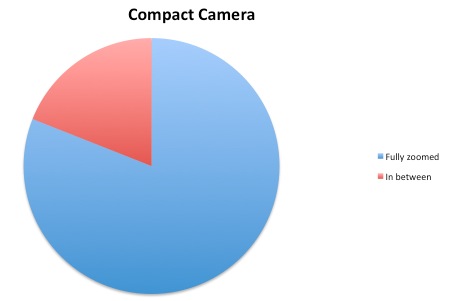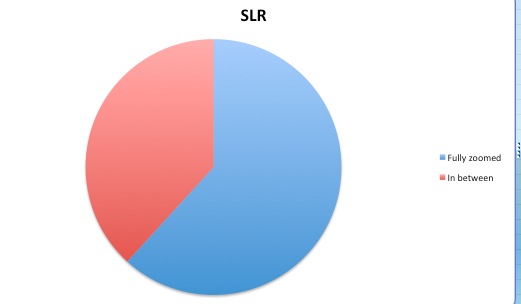
I was taking photos at Angkor Wat in Cambodia yesterday with my Olympus E-P1, and noticed something about my pattern of taking photos: Most of the time, I'm taking pictures either fully zoomed in, or fully zoomed out. It was annoying me, because I figured that showed a weakness in the lens: Basically, it was never wide - or long - enough for the photos I really wanted to take.
Then I continued thinking, and I was wondering - isn't that true whenever I take photos with a zoom lens? So I thought up a little test - by going through my Lightroom library and doing a spot of statistical analysis.
Compact cameras: 81% fully zoomed in or out

When I analysed my images, I realised that my compact camera images, especially, were prone to shooting at full zoom. 75% of my photos are shot fully zoomed out - which makes sense, and is probably a conscious choice: All my compact cameras have variable aperture lenses, so they are brighter when it's at full wide angle. I didn't realise quite how often I shoot at fully wide, however, and a full three-quarters of my images were a surprise to me.
I guess a corollary of the above explains how only a measly 6% of my compact camera images are taken at full zoom.
SLR images: 62% fully zoomed in or out

The difference for SLR images was slightly less than that for my compact images. 44% of the photos are taken fully zoomed out, 18% are shot at full zoom, and a more reasonable 38% are taken somewhere in between.
Of course, I make no secret of my love for prime lenses - and a huge amount of the images in my library are taken with primes. I decided to exclude them from the statistical data, but if they were included, obviously the results would have been skewed significantly towards 'at the end of the zoom range'.
But what does it mean?

The idea I had is that whenever I shoot at one of the extremes of my zoom lens, it means that I brought the wrong lens. If I was shooting with a 28-135mm lens, and 'perfect' exposure was at 44mm, I would shoot at 44mm, right? Similarly, if I shoot at 30mm or 130mm, I'm still inside the zoom range, so I chose to shoot at that particular focal lengths. When I end up taking pictures at the extremes of the zoom lens, it probably means that I didn't choose the focal length: it was made for me, by the focal length limitations of the lens.
I have no idea if I'm a typical photographer or not, so I don't know if my finding is universally applicable, or if it's just a quirk in my photo style, but none the less...
It dawned on me then, that I'm often more frustrated when I use a zoom lens than when I'm shooting with a prime. Perhaps the main difference is that when I'm taking photos with a prime lens, I've grown used to the limitation - it takes the challenge of zooming out of the equation, and if the 'perfect' focal lengths is outside the very limited 'range' of my prime, I am happy with the fact that I made this choice. Whereas when I'm taking photos with a zoom lens, the limitations are my own dumb fault, for picking the wrong zoom range.
Just goes to show, I suppose, that sometimes you can feel more free with greater limitations than with greater freedom...
Methodology
In my library of more than 15,000 photos, a lot of them were taken with my Canon Powershot S95 in an underwater housing. Because the underwater housing doesn't have any zoom settings, they were per definition taken at fully zoomed out, so that discounted nearly 1,000 photos from this data. In addition, a lot of my photos are taken with prime lenses - 50mm or 100mm primes, mostly - so I took them out as well (although some might argue that a prime lens is per definition 'fully zoomed out', and could be counted). I then wrote a little script that checks whether each photo is taken within 1mm of the extremes of the zoom range of each lens. (so, for a 70-200mm lens, it checked for photos taken at wider than 71mm and narrower than 199mm).
The resulting data, I dumped into a spreadsheet for analysis. The sample size is 4,913 images, taken with 10 different zoom lenses. 71% of the images were taken with SLR cameras, and the remaining images were taken with a series of different compact cameras.
produce wholly or in part without a license. More info.
Do you enjoy a smattering of random photography links? Well, squire, I welcome thee to join me on Twitter - Follow @Photocritic
© Kamps Consulting Ltd. This article is licenced for use on Pixiq only. Please do not reproduce wholly or in part without a license. More info.





